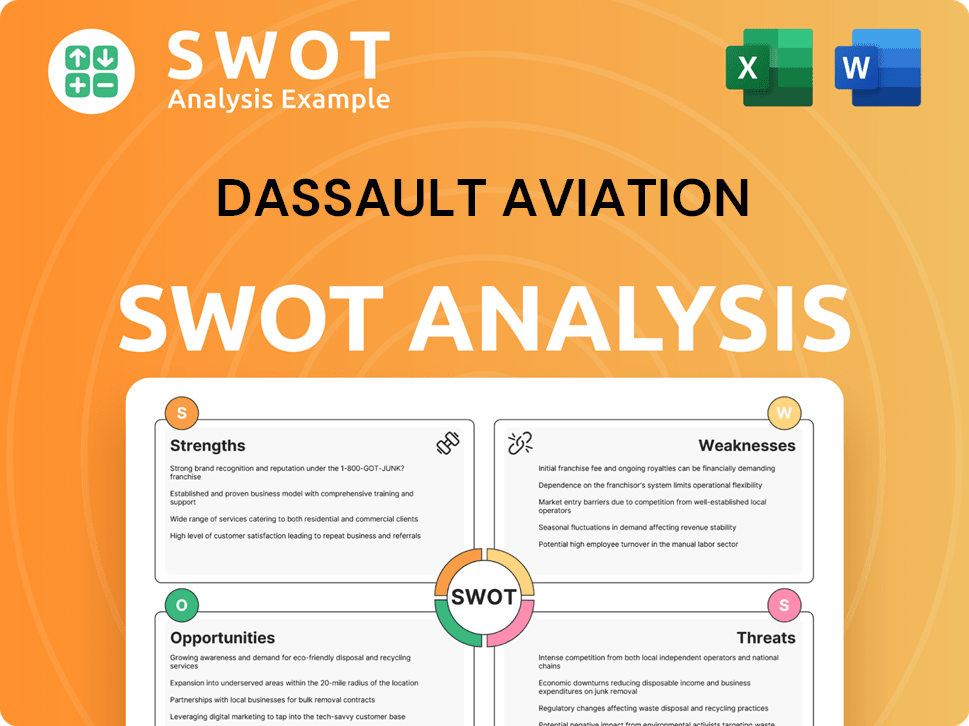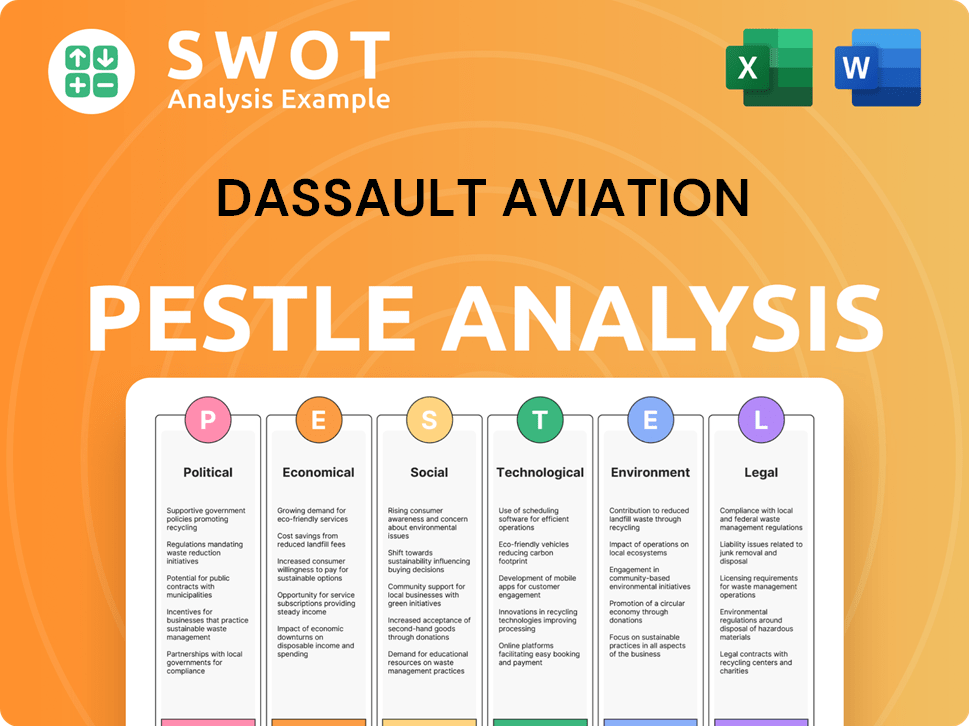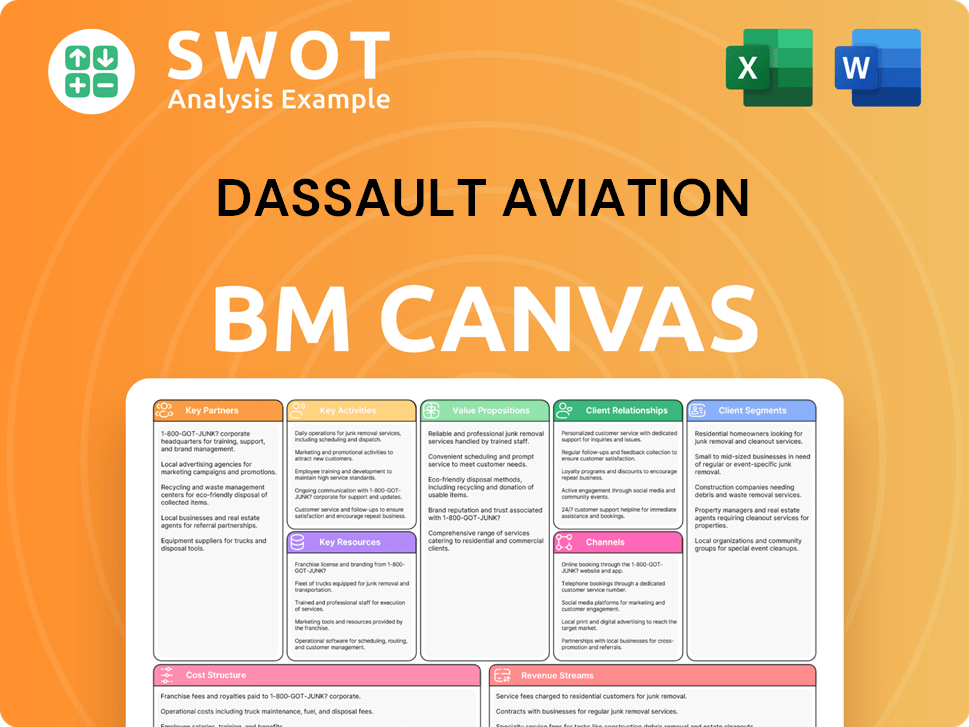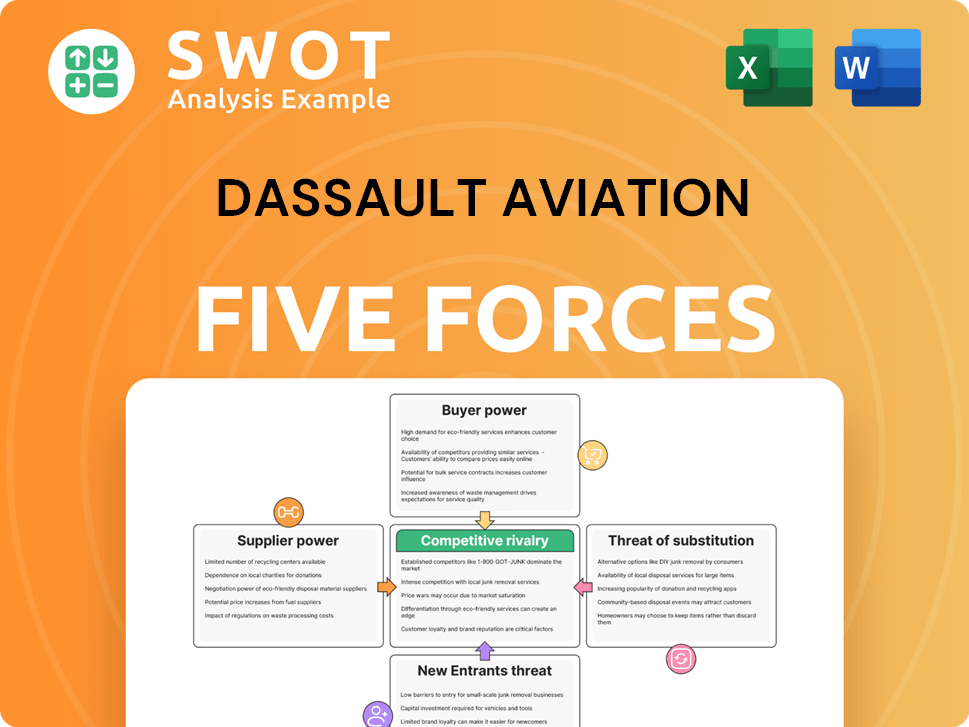Dassault Aviation Bundle
Can Dassault Aviation Soar to New Heights?
Dassault Aviation, a cornerstone of the Dassault Aviation SWOT Analysis, has navigated the complexities of the aerospace and defense industry since 1929. This French aerospace giant, known for its Rafale fighter jet and Falcon business jets, has consistently demonstrated its ability to adapt and thrive. With a record backlog and a balanced portfolio, what strategic initiatives will fuel Dassault Aviation's future growth?

This exploration delves into Dassault Aviation's Growth Strategy and Future Prospects, examining its Dassault Aviation market analysis and financial performance. We'll analyze the company's strategic initiatives, including its expansion plans within the Defense Industry and the evolution of its Business Jets segment. Understanding the Dassault Aviation competitive landscape and long-term vision is crucial for investors and strategists alike, as we consider the challenges and opportunities ahead.
How Is Dassault Aviation Expanding Its Reach?
Dassault Aviation's Growth Strategy is centered on expanding its market reach and diversifying its revenue streams. This involves significant initiatives in both the military and civil aviation sectors. The company is leveraging export orders and international partnerships to boost sales of its military aircraft, while simultaneously renewing its business jet range to capture a larger share of the market.
The company's Future Prospects look promising, driven by strategic expansions and product innovations. Dassault is focused on increasing its global presence through strategic partnerships and investments in after-sales support, which is expected to drive long-term growth. These initiatives are crucial for maintaining its competitive edge in the French Aerospace industry.
The company is also focusing on sustainability efforts, which is an important factor for the long-term vision of the company. The company's ability to adapt to changing market dynamics and technological advancements will be key to its continued success. For more information about the company, you can read Revenue Streams & Business Model of Dassault Aviation.
Dassault Aviation is actively expanding its military aircraft sales through export orders. In 2024, the company secured 30 export orders for the Rafale fighter jet. This includes orders from Indonesia (18 units) and Serbia (12 units).
The company is strengthening international partnerships to support its expansion. In April 2025, Dassault secured an additional 26-unit order for Rafale Marine jets from the Indian Navy. Deliveries are projected to begin in 2028.
Dassault is assessing the possibility of establishing a final assembly line for the Rafale fighter jet in India. This aligns with India's 'Make in India' initiative, aimed at boosting domestic defense manufacturing. This move is crucial for managing production demands.
In the civil aviation sector, Dassault is renewing its Falcon business jet range. The Falcon 6X entered service in early 2024, and the ultra-long-range Falcon 10X is targeted for initial deliveries by the end of 2027. The company aims to increase its market share in the Business Jets sector to 20% by 2025.
Dassault Aviation is expanding its global support infrastructure to enhance customer service and after-sales support. This expansion is supported by the strong export performance of the Rafale and the launch of the Falcon 6X. This expansion is a key investment in the Defense Industry.
- In April 2024, a new Maintenance, Repair, and Overhaul (MRO) center was opened in Kuala Lumpur, Malaysia.
- The MRO center is capable of servicing Falcon 6X and future Falcon 10X aircraft.
- These initiatives are designed to improve customer satisfaction and support the company's growth.
- The expansion of after-sales support is a key investment.
Dassault Aviation SWOT Analysis
- Complete SWOT Breakdown
- Fully Customizable
- Editable in Excel & Word
- Professional Formatting
- Investor-Ready Format

How Does Dassault Aviation Invest in Innovation?
Dassault Aviation's Growth Strategy is heavily reliant on continuous innovation and technological advancements, which are supported by significant investments in research and development. This approach is crucial for maintaining its competitive edge in both the French Aerospace and global markets.
The company's focus on innovation is evident in its commitment to digital transformation, sustainability, and the development of advanced aircraft. These initiatives are key to ensuring Future Prospects and long-term success.
Dassault Aviation's dedication to technological progress is a cornerstone of its strategy, influencing its market position and its ability to meet evolving customer needs in the Defense Industry and the Business Jets sector.
In 2024, Dassault Aviation allocated roughly 8% of its revenue to research and development. This substantial investment underscores its commitment to innovation and technological advancement.
The company's R&D efforts are concentrated on key projects such as the Falcon 6X, Falcon 10X, and the Rafale F5 standard. These initiatives are vital for maintaining its competitive edge.
Dassault Aviation is leveraging technologies like AI, IoT, and big data to enhance the monitoring and analytical capabilities of its products and production systems. This includes capturing and storing data on a single platform to improve aircraft performance and operational efficiency.
The company uses tools like 3DExperience and SAP solutions to streamline production processes and improve coordination between design and manufacturing teams. A 2024 agreement with Airbus and Dassault Systèmes highlights the use of the 3DEXPERIENCE platform for digital design and manufacturing.
Dassault is actively involved in the development of the Rafale F5 standard, which will introduce manned/unmanned teaming, advanced connectivity, and sensor fusion. The development phase of an unmanned combat air system (UCAS) was launched on October 8, 2024, for integration after 2030.
Dassault Aviation aims for a 50% reduction in greenhouse gas emissions by 2030 and is developing more eco-efficient aircraft. In 2024, the company operated 752 flights using SAF blends, saving over 1,800 metric tons of CO2.
Dassault Aviation's strategic initiatives include continuous innovation in aircraft design, digital transformation, and a strong focus on sustainability. These efforts are critical for maintaining its competitive position and driving future growth. For more insights, you can refer to this article about Dassault Aviation's strategic approach.
- New Aircraft Development: Ongoing development of the Falcon 6X and Falcon 10X, and multi-mission aircraft such as the Falcon 2000LXS-based 'AVSIMAR' and the Falcon 8X-based 'Archange'.
- Digital Transformation: Implementing AI, IoT, and big data to improve aircraft performance and operational efficiency.
- Sustainability: Aiming for a 50% reduction in greenhouse gas emissions by 2030 and promoting the use of Sustainable Aviation Fuels (SAFs).
- Rafale F5 Standard: Development of the Rafale F5 standard, incorporating manned/unmanned teaming and advanced sensor capabilities.
Dassault Aviation PESTLE Analysis
- Covers All 6 PESTLE Categories
- No Research Needed – Save Hours of Work
- Built by Experts, Trusted by Consultants
- Instant Download, Ready to Use
- 100% Editable, Fully Customizable

What Is Dassault Aviation’s Growth Forecast?
The financial outlook for Dassault Aviation appears robust, driven by strong order intake and a growing backlog. The company's performance in 2024 sets a positive tone for future expansion. The French Aerospace company is well-positioned for continued success in both the business jet and defense sectors.
In 2024, Dassault Aviation achieved significant financial milestones, including a substantial increase in revenue and adjusted net income. The company's strategic focus on expanding its global presence, coupled with innovation in aircraft development, is expected to drive future growth. This positive trajectory is supported by a strong order book and a commitment to delivering value to shareholders.
Dassault Aviation's financial health is further underscored by its substantial cash reserves and improved operating margins. The company's strategic decisions, such as maintaining a net cash position, reflect a commitment to financial stability. Moreover, the proposed increase in dividends for fiscal year 2024 demonstrates confidence in its financial performance and future prospects.
In 2024, Dassault Aviation reported revenues of €6.2 billion, marking a 29% increase from 2023. This significant growth reflects strong demand and successful execution across its business segments. The company's ability to increase its top line is a key indicator of its market position.
The consolidated order intake for 2024 was €10.87 billion, a considerable increase from €8.25 billion in 2023. This strong order intake resulted in a record backlog of €43.2 billion as of December 31, 2024, providing a solid foundation for future revenue streams. Export orders accounted for 90% of the total.
For 2025, Dassault Aviation anticipates an increase in net sales to approximately €6.5 billion. This forecast includes projected deliveries of 40 Falcon business jets and 25 Rafale fighter jets. The company's guidance suggests continued growth momentum.
In 2024, the company delivered 21 Rafales and 31 Falcons. While exceeding its Rafale delivery target of 20, it fell short of its Falcon target of 35 due to supply chain issues. These figures highlight the company's production capabilities and challenges.
Analysts anticipate Dassault's top line to average a 14% compound annual growth rate over the forecast period. This growth is expected to be driven by both defense and business aviation sectors. This indicates a positive outlook for the company's future.
Dassault Aviation's available cash stood at €8.4 billion as of December 31, 2024, up from €7.3 billion in 2023. This strong cash position provides financial flexibility. The company's robust financial health supports its strategic initiatives.
The adjusted consolidated operating margin was 8.3% in 2024, an increase from 7.3% in 2023. This improvement in operating margin reflects enhanced operational efficiency. The company's ability to improve profitability is a positive sign.
The board is proposing a dividend of €4.72 per share for fiscal year 2024, higher than the €3.37 per share in 2023. Recurring, high-margin aftermarket revenue is expected to increase from 22% of sales in 2021 to about 25% of sales. This indicates a commitment to shareholder value.
While the company maintains a net cash position, it also has net contract liabilities of €12 billion relating to upfront and progress payments. This reflects the nature of its long-term contracts. This is a normal part of the business.
Understanding the competitive landscape is crucial for assessing Dassault Aviation's position. For a deeper dive into the competitive environment, consider reading about the Competitors Landscape of Dassault Aviation.
Dassault Aviation Business Model Canvas
- Complete 9-Block Business Model Canvas
- Effortlessly Communicate Your Business Strategy
- Investor-Ready BMC Format
- 100% Editable and Customizable
- Clear and Structured Layout

What Risks Could Slow Dassault Aviation’s Growth?
The Dassault Aviation faces several risks and obstacles that could impact its Growth Strategy and Future Prospects. These challenges span operational hurdles, market competition, and geopolitical factors. Navigating these issues is vital for the company's continued success in the French Aerospace industry.
One primary concern is the persistent disruption to the supply chain, which has affected the production of Falcon business jets, despite the opening of a new plant in 2024. The ability to increase production rates for complex aircraft, like the Rafale, is also a long-term process, requiring about two years for each incremental step. These supply chain issues prevented the company from reaching its Falcon delivery targets in 2024, posing a challenge for 2025 as well.
Market competition also presents a significant hurdle for Dassault Aviation. While the defense segment, with its Rafale fighter jets, enjoys a strong market position, the civil division faces more intense competition. This has led to a decline in the company’s business jet market share, dropping from 37% in 2010 to 13% in 2023, highlighting the need for strategic adjustments to maintain competitiveness.
Supply chain issues have hindered production, particularly for Falcon business jets. The company opened a new plant in Cergy in 2024 to address production constraints. Increasing production rates for complex aircraft takes approximately two years for each step.
The aerospace sector is highly competitive, with major players like Boeing and Airbus. The civil division faces more intense competition. The business jet market share declined from 37% in 2010 to 13% in 2023.
Potential tariffs, such as a 25% tax on aircraft imports to the U.S., could affect Falcon sales. Geopolitical tensions and combat outcomes can affect military aircraft sales. Claims of Rafale jet losses in the India-Pakistan conflict raised concerns.
Aviation technology's complexity and long-term contracts create risks in meeting schedules. Managing partners and suppliers while observing constraints is crucial. Digital transformation, based on 3DExperience and SAP solutions, is a key focus.
The company addresses risks through industry collaboration and increased investment. It also focuses on supplier support, alternative sourcing, and proactive internal oversight. Participation in investment funds for the French aeronautics supply chain is also important.
Digital transformation, using 3DExperience and SAP solutions, is critical for improving coordination and operational management. This helps the company improve its efficiency and responsiveness. This includes measures to improve the internal oversight.
Regulatory changes and geopolitical factors also pose risks. For example, potential new tariffs in the United States, such as a proposed 25% tariff on aircraft imports, could impact Falcon business jet sales, as the U.S. accounts for one-third of Falcon deliveries. Additionally, geopolitical tensions and real-world combat outcomes can affect the reputation and sales of military aircraft. For more information on the potential customer base, read about the Target Market of Dassault Aviation.
The company faces persistent supply chain disruptions, particularly impacting Falcon business jet production. Market competition with major players like Boeing and Airbus also presents a challenge. Regulatory changes and geopolitical events further complicate the landscape.
Supply chain issues prevented the company from reaching its Falcon delivery targets in 2024. The civil division's business jet market share decreased from 37% in 2010 to 13% in 2023. Potential tariffs on aircraft imports could impact sales.
The company is working on industry collaboration, increased investment, and supplier support. It is also focusing on alternative sourcing and proactive internal oversight. Digital transformation, using 3DExperience and SAP solutions, is a key focus.
The complexity of aviation technology and long-term contracts pose risks. Managing numerous partners and suppliers while adhering to various constraints is crucial. The Dassault Rafale fighter jet future depends on geopolitical stability and performance.
Dassault Aviation Porter's Five Forces Analysis
- Covers All 5 Competitive Forces in Detail
- Structured for Consultants, Students, and Founders
- 100% Editable in Microsoft Word & Excel
- Instant Digital Download – Use Immediately
- Compatible with Mac & PC – Fully Unlocked

Related Blogs
- What are Mission Vision & Core Values of Dassault Aviation Company?
- What is Competitive Landscape of Dassault Aviation Company?
- How Does Dassault Aviation Company Work?
- What is Sales and Marketing Strategy of Dassault Aviation Company?
- What is Brief History of Dassault Aviation Company?
- Who Owns Dassault Aviation Company?
- What is Customer Demographics and Target Market of Dassault Aviation Company?
Disclaimer
All information, articles, and product details provided on this website are for general informational and educational purposes only. We do not claim any ownership over, nor do we intend to infringe upon, any trademarks, copyrights, logos, brand names, or other intellectual property mentioned or depicted on this site. Such intellectual property remains the property of its respective owners, and any references here are made solely for identification or informational purposes, without implying any affiliation, endorsement, or partnership.
We make no representations or warranties, express or implied, regarding the accuracy, completeness, or suitability of any content or products presented. Nothing on this website should be construed as legal, tax, investment, financial, medical, or other professional advice. In addition, no part of this site—including articles or product references—constitutes a solicitation, recommendation, endorsement, advertisement, or offer to buy or sell any securities, franchises, or other financial instruments, particularly in jurisdictions where such activity would be unlawful.
All content is of a general nature and may not address the specific circumstances of any individual or entity. It is not a substitute for professional advice or services. Any actions you take based on the information provided here are strictly at your own risk. You accept full responsibility for any decisions or outcomes arising from your use of this website and agree to release us from any liability in connection with your use of, or reliance upon, the content or products found herein.